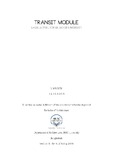| dc.contributor.advisor | Reza, Dr Md Habib | |
| dc.contributor.advisor | Jabeen, Dr Huraera | |
| dc.contributor.advisor | Ahmed, Dr Iftekhar | |
| dc.contributor.author | Najem, A M | |
| dc.date.accessioned | 2018-11-05T03:33:34Z | |
| dc.date.available | 2018-11-05T03:33:34Z | |
| dc.date.copyright | 2018 | |
| dc.date.issued | 2018 | |
| dc.identifier.issn | ID 12108003 | |
| dc.identifier.uri | http://hdl.handle.net/10361/10798 | |
| dc.description | This thesis is submitted in partial fulfillment of the requirements for the degree of Bachelor of Architecture, 2018. | en_US |
| dc.description | Cataloged from PDF version of thesis. | |
| dc.description | Includes bibliographical references (page 74). | |
| dc.description.abstract | In a densely populated city like Dhaka, a proper transport solution is a prime demand as
well as difficult to achieve. Through years, numerous infrastructural developments took
place in Dhaka which is considered as neither a failure nor appropriate. Most of the
plans costs great tolls in order to provide facilities. Tangible and intangible tolls. This
thesis is about generating a process which will be an answer to the present transport
malfunction of Dhaka city by identifying one of these grey infrastructural proposals and
an attempt to provide an appropriate system in terms of efficiency, effectiveness,
economy and publicness according to the context of a contemporary city. So, this thesis
needs a sample site to undergo the research process which is Farmgate since it is a
major transitional node of the transportation system in Dhaka city. This thesis envisions
the transitional node of Farmgate as a multimodal transportation hub which will be a
modular approach for other nodes with same characteristics. This thesis will establish
the appropriateness of this idea by analyzing the existing context within 1 km radius as
sample and from these data, a thorough comparative analysis will be done from 3
probable possibilities in 3 different location. The outcome will challenge the existing
location of MRT station over SherE Bangla Nagar park and rethinks its position that has
not enough open space. The adjacent buildings of the transportation node are all
commercial marketplace. This paper will try to find the answer to approximate
possibility of merging the multimodal hub with the existing commercial buildings. To
achieve the answer, a macro level study and a micro level study of the site is going to be
done. In macro level mapping, the connection of farmgate with other transportation
hubs will be shown. A structural survey is needed to determine the existing situation of the buildings that adjacent to the node. The total count of existing registered vehicle is
needed to determine the vehicular pressure at the node. It will also determine the modal
change of people. A thorough survey of pedestrian movement is needed to understand
the pedestrian movement pattern and public behavior. A mixed method questionnaire
survey will be done on regular passersby of Farmgate to understand the nature of userfriendliness
of the transitional node. After analyzing all the gathered data, there will be a
designed tangible intervention of the idea which is a multimodal hub containing
transportation, recreational, educational, healthcare facilities and civic space. | en_US |
| dc.description.statementofresponsibility | A M Najem | |
| dc.format.extent | 74 pages | |
| dc.language.iso | en | en_US |
| dc.publisher | BRAC University | en_US |
| dc.rights | BRAC University theses are protected by copyright. They may be viewed from this source for any purpose, but reproduction or distribution in any format is prohibited without written permission. | |
| dc.subject | Traffic jam | en_US |
| dc.subject | Rapid transit | en_US |
| dc.subject | Transportation | en_US |
| dc.subject.lcsh | Local transit--Bangladesh. | |
| dc.subject.lcsh | Local transit accessibility--Dhaka. | |
| dc.title | Transit module: architecture for enhancing mobility | en_US |
| dc.type | Thesis | en_US |
| dc.contributor.department | Department of Architecture, BRAC University | |
| dc.description.degree | B. Architecture | |

